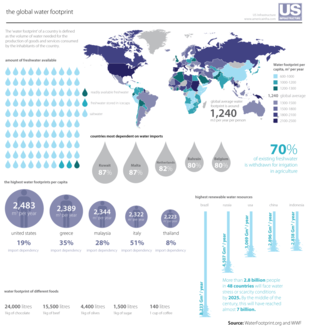
Back بصمة مائية Arabic Consum d'aigua Catalan Vodní stopa Czech Huella hídrica Spanish Ur-aztarna Basque ردپای آب Persian Vesijalanjälki Finnish Empreinte eau French Ջրօգտագործում Armenian Impronta idrica Italian

A water footprint shows the extent of water use in relation to consumption by people.[1] The water footprint of an individual, community, or business is defined as the total volume of fresh water used to produce the goods and services consumed by the individual or community or produced by the business. Water use is measured in water volume consumed (evaporated) and/or polluted per unit of time. A water footprint can be calculated for any well-defined group of consumers (e.g., an individual, family, village, city, province, state, or nation) or producers (e.g., a public organization, private enterprise, or economic sector), for a single process (such as growing rice) or for any product or service.[2]
Traditionally, water use has been approached from the production side, by quantifying the following three columns of water use: water withdrawals in the agricultural, industrial, and domestic sector. While this does provide valuable data, it is a limited way of looking at water use in a globalised world, in which products are not always consumed in their country of origin. International trade of agricultural and industrial products in effect creates a global flow of virtual water, or embodied water (akin to the concept of embodied energy).[1]
In 2002, the water footprint concept was introduced in order to have a consumption-based indicator of water use, that could provide useful information in addition to the traditional production-sector-based indicators of water use. It is analogous to the ecological footprint concept introduced in the 1990s. The water footprint is a geographically explicit indicator, not only showing volumes of water use and pollution, but also the locations.[3] The global issue of water footprinting underscores the importance of fair and sustainable resource management. Due to increasing water shortages, climate change, and environmental concerns, transitioning towards a fair impact of water use is critical. The water footprint concept offers detailed insights for adequate and equitable water resource management. It advocates for a balanced and sustainable water-use approach, aiming to tackle global challenges. This approach is essential for responsible and equitable water resource utilization globally. Thus, it gives a grasp on how economic choices and processes influence the availability of adequate water resources and other ecological realities across the globe (and vice versa).
- ^ a b "Water footprints of nations: Water use by people as a function of their consumption pattern" (PDF). Water Footprint Network. Archived from the original (PDF) on 17 April 2018. Retrieved 3 March 2018.
- ^ "Waterfootprint.org: Water footprint and virtual water". The Water Footprint Network. Retrieved 30 October 2023.
- ^ Definition taken from the Hoekstra, A.Y. and Chapagain, A.K. (2008) Globalization of water: Sharing the planet's freshwater resources, Blackwell Publishing, Oxford, UK.
© MMXXIII Rich X Search. We shall prevail. All rights reserved. Rich X Search